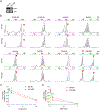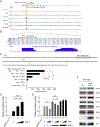HTLV-1 bZIP factor impairs DNA mismatch repair system
- PMID: 36972660
- PMCID: PMC10115849
- DOI: 10.1016/j.bbrc.2023.03.049
HTLV-1 bZIP factor impairs DNA mismatch repair system
Abstract
Adult T-cell leukemia (ATL) is a peripheral T-cell malignancy caused by human T-cell leukemia virus type 1 (HTLV-1). Microsatellite instability (MSI) has been observed in ATL cells. Although MSI results from impaired mismatch repair (MMR) pathway, no null mutations in the genes encoding MMR factors are detectable in ATL cells. Thus, it is unclear whether or not impairment of MMR causes the MSI in ATL cells. HTLV-1 bZIP factor (HBZ) protein interacts with numerous host transcription factors and significantly contributes to disease pathogenesis and progression. Here we investigated the effect of HBZ on MMR in normal cells. The ectopic expression of HBZ in MMR-proficient cells induced MSI, and also suppressed the expression of several MMR factors. We then hypothesized that the HBZ compromises MMR by interfering with a transcription factor, nuclear respiratory factor 1 (NRF-1), and identified the consensus NRF-1 binding site at the promoter of the gene encoding MutS homologue 2 (MSH2), an essential MMR factor. The luciferase reporter assay revealed that NRF-1 overexpression enhanced MSH2 promoter activity, while co-expression of HBZ reversed this enhancement. These results supported the idea that HBZ suppresses the transcription of MSH2 by inhibiting NRF-1. Our data demonstrate that HBZ causes impaired MMR, and may imply a novel oncogenesis driven by HTLV-1.
Keywords: ATL; DNA mismatch Repair; HBZ; HTLV-1; MSI; NRF-1.
Copyright © 2023 Elsevier Inc. All rights reserved.
Conflict of interest statement
Declaration of competing interest The authors declare the following financial interests/personal relationships which may be considered as potential competing interests: Masao Matsuoka reports a relationship with Kyowa Kirin Co Ltd that includes: speaking and lecture fees. Masao Matsuoka reports a relationship with Meiji Seika Pharma Co Ltd that includes: speaking and lecture fees. Masao Matsuoka reports a relationship with Bristol Myers Squibb Co that includes: speaking and lecture fees. Masao Matsuoka reports a relationship with Chugai Pharmaceutical Co Ltd that includes: speaking and lecture fees. Akifumi Takaori-Kondo reports a relationship with Ono Pharmaceutical Co Ltd that includes: funding grants.
Figures




References
-
- Uchiyama T, Yodoi J, Sagawa K, et al., Adult T-cell leukemia: clinical and hematologic features of 16 cases, Blood 50 (1977) 481–492. - PubMed
Publication types
MeSH terms
Substances
Grants and funding
LinkOut - more resources
Full Text Sources
Miscellaneous

